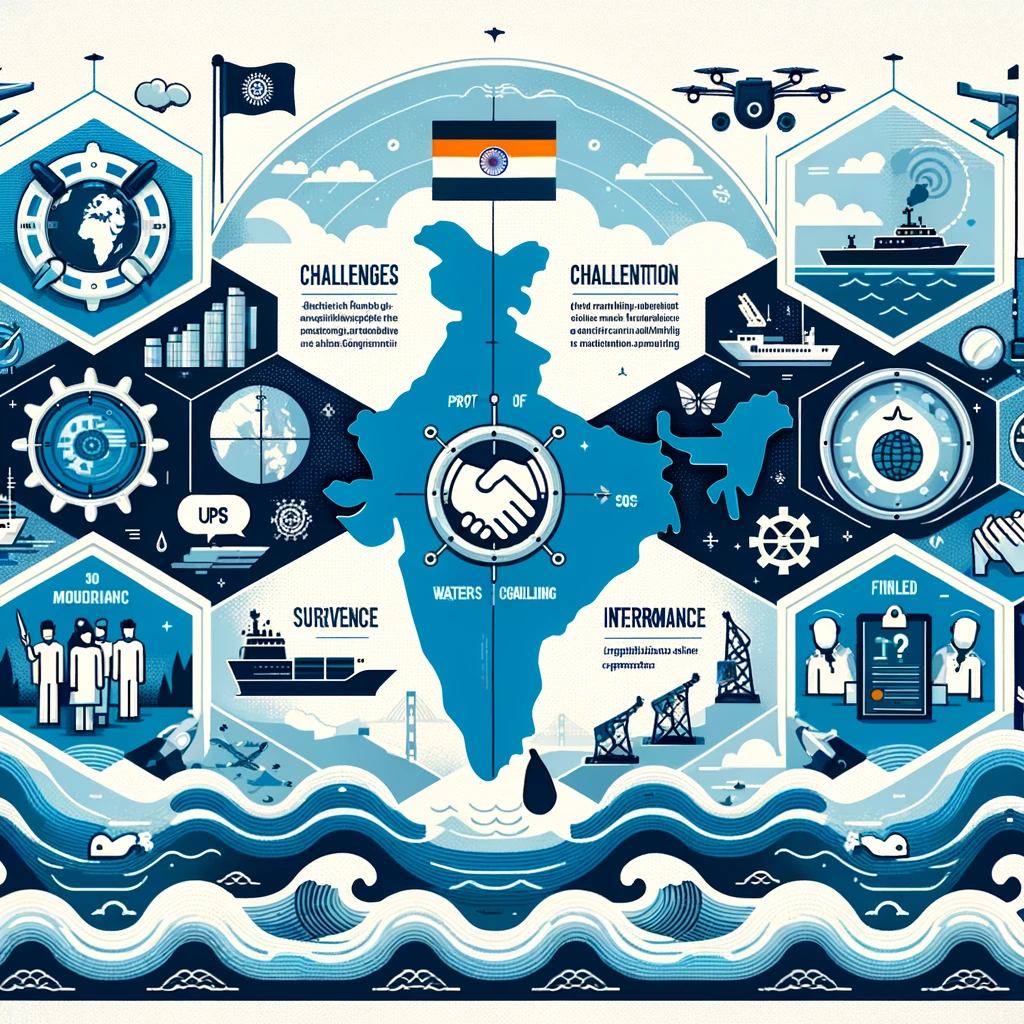
Charles Darwin posited that the essence of human survival and advancement lies in our ability to adapt to changing environments. He proposed that it’s not necessarily the strongest or most intelligent species that thrives, but rather those capable of resilience and adaptability. This idea has stood the test of time, proving especially pertinent in the maritime sphere, where confronting emerging challenges demands a nimble and flexible approach.
These challenges include piracy, terrorism, illegal fishing, and environmental degradation, alongside the shadow of great power rivalry. Such threats demand a nuanced understanding and a strategic approach to ensure the security of vital sea lanes and protect the economic interests that are the lifeline of many nations.
For India, the stakes are high. The nation’s economic vitality and strategic interests are inextricably linked to the Indian Ocean, making maritime security a national imperative. This complex security environment requires India to bolster its naval capabilities, foster regional cooperation, and navigate the delicate balance of power in the Indo-Pacific region.
Significance of Maritime Security for India
Vulnerabilities of India’s Coastline:
- India’s 7,000 km coastline faces threats like piracy, terrorism, smuggling, illegal fishing, and environmental degradation.
- Coastal and offshore assets such as oil and gas installations, fishing grounds, and ports need protection.
Economic Dependency on the Sea:
- Over 70% of India’s trade value and nearly 95% of its trade volume is carried out via sea routes.
- Most of India’s energy needs are met through sea-borne imports, particularly from the Gulf region.
Security of Sea Lanes of Communication (SLOCs):
- Ensuring security and freedom of navigation of SLOCs in the Indian Ocean and beyond is crucial for India’s economic growth and energy security.
Strategic Interest in the Indian Ocean Region (IOR):
- India holds a strategic interest in the IOR, which houses friendly nations as well as potential adversaries.
- Historical, cultural, and diasporic ties bind India with many countries in the IOR.
- India invests in the development and security of nations in the IOR.
Why Maritime Security Matters for India
- Vulnerability Due to Long Coastline: India has a very long coastline, over 7,000 km, which exposes it to various dangers like piracy, terrorism, smuggling, illegal fishing, and environmental harm.
- Protecting Vital Assets: India needs to safeguard its coastal areas and offshore installations, including oil and gas facilities, fishing zones, and ports, from these risks.
- Economic Dependency on the Sea: The sea plays a crucial role in India’s economy. More than 70% of its trade value and nearly 95% of its trade volume happen through maritime routes. Additionally, India relies heavily on sea imports for energy, especially from the Gulf region.
- Ensuring Sea Routes and Energy Security: To maintain economic growth and energy stability, India must secure the Sea Lanes of Communication (SLOCs) in the Indian Ocean and other regions. These routes are vital for trade and energy supplies.
- Strategic Importance of the Indian Ocean Region (IOR): India has strategic interests in the IOR, which includes friendly nations, potential adversaries, and countries with historical, cultural, and diasporic connections. India invests in the development and security of these nations.
Challenges in the Maritime Domain
Hard Security Challenges
- Asymmetrical Tactics:
- Ukraine’s actions against Russia in the Black Sea and China’s deployment of maritime militias in the South China Sea highlight the use of unconventional tactics.
- These tactics deviate from traditional military strategies and can catch opponents off guard.
- Grey-Zone Warfare:
- Tactics falling between conventional and unconventional methods create ambiguity in response strategies.
- Covert operations and actions below the threshold of open conflict exploit legal and policy uncertainties.
- Combat Drones:
- The utilization of combat drones enhances reconnaissance, surveillance, and potential attack capabilities.
- Both states and non-state actors leverage drones to disrupt maritime operations.
- Land Attack Missiles:
- The deployment of land attack missiles at sea poses a direct threat to maritime security.
- Missiles targeting land-based facilities from maritime platforms challenge traditional sea-based defense notions.
Unconventional Security Threats
- Illegal Fishing:
- Illegal fishing activities deplete marine resources and harm coastal communities’ livelihoods.
- Incidents like Sri Lankan fishermen fishing in Indian waters contribute to tensions and security concerns.
- Natural Disasters:
- Increasing frequency and intensity of natural disasters, such as cyclones and tsunamis, challenge maritime security and emergency response efforts.
- The maritime domain faces heightened vulnerability to environmental disruptions.
- Marine Pollution:
- Pollution, including oil spills and plastic waste, poses environmental and economic threats.
- Efforts to mitigate marine pollution are essential for preserving marine ecosystems and sustainable maritime activities.
- Human and Drug Trafficking:
- Illicit activities like human and drug trafficking exploit maritime routes.
- Such activities contribute to insecurity and pose challenges for maritime law enforcement agencies.
- Climate Change Impact:
- Rising sea levels and climate change disproportionately affect less developed states.
- Vulnerability to extreme weather events increases, impacting maritime infrastructure and livelihoods.
- Zero-Sum Competition in the Indo-Pacific:
- The rivalry between powerful nations in the Indo-Pacific region threatens the security interests of littoral states.
- Zero-sum competition dynamics divert attention and resources away from addressing security concerns, particularly for developing nations.
Challenges in Maritime Governance
- Lack of Coordination:
- Littoral states struggle to coordinate efforts in combating maritime threats due to unequal capabilities and varying priorities.
- Challenges in the South China Sea, including ASEAN countries’ reluctance to confront China’s actions, reflect this coordination deficit.
- Reluctance to Cooperate:
- Some littoral states resist maritime cooperation with foreign agencies to reduce reliance on external assistance.
- This reluctance hampers the development of comprehensive security measures.
- Information Sharing Challenges:
- Despite willingness to share information, limitations exist in collaboration extent due to security and sovereignty concerns.
- Agreements like those between India and the USA aim to enhance information sharing but face hurdles in implementation.
Enhancing Maritime Security in India
Capacity Augmentation of Maritime Security Agencies:
- Modernization and expansion of the Indian Navy, Coast Guard, and Marine Police.
- Acquisition of advanced platforms like aircraft carriers, submarines, frigates, and helicopters.
- Procurement of sophisticated equipment such as radars and satellites to bolster surveillance and patrol capabilities.
Enhanced Technical Surveillance of Coastal and Offshore Areas:
- Implementation of projects like the Coastal Surveillance Network and the National Command Control Communication and Intelligence Network.
- Deployment of the National Automatic Identification System and the National Maritime Domain Awareness Project.
- Aim to provide a comprehensive view of maritime activities for swift threat detection and response.
Establishment of Mechanisms for Inter-Agency Coordination:
- Creation of bodies like the National Committee for Strengthening Maritime and Coastal Security and the National Maritime Security Coordinator.
- Operation of Joint Operations Centres and Coastal Security Operations Centres to ensure effective coordination and information sharing among stakeholders.
Integration of Fishing and Coastal Communities:
- Issuance of biometric identity cards and installation of transponders and distress alert transmitters.
- Community awareness and education programs to involve fishing and coastal communities in maritime security.
- Provision of livelihood and welfare schemes to enhance their security and well-being.
Initiatives Beyond National Borders:
- Security and Growth for All in the Region (SAGAR): An initiative focusing on ensuring security and promoting development in the Indian Ocean region.
- Indian Ocean Naval Symposium (IONS): A platform for naval cooperation among Indian Ocean littoral states.
- Indian Ocean Rim Association (IORA): A regional forum promoting cooperation and sustainable development among Indian Ocean Rim countries.
Overcoming Maritime Challenges:
Enhanced Cooperation Among Nations:
- Strengthen cooperation among like-minded countries through various mechanisms such as the Quad, IORA, and ARF.
- Foster information-sharing, joint exercises, capacity-building, and coordination to address common threats.
Development of Common Code of Conduct:
- Establish a common code of conduct based on international law, particularly UNCLOS principles.
- This code can prevent disputes, manage tensions, and promote confidence-building measures.
Empowerment of Maritime Law Enforcement Agencies:
- Enhance the capabilities of coast guards and maritime law enforcement agencies.
- These agencies serve as first responders to threats like piracy, smuggling, and pollution.
- They also contribute to maritime domain awareness and provide humanitarian assistance during disasters.
Addressing Root Causes of Threats:
- Tackle poverty, inequality, corruption, and governance issues which contribute to non-conventional threats.
- Climate change mitigation and sustainable development efforts are essential.
- Focus on improving the livelihoods and resilience of coastal communities.
Conclusion
India is steadfast in safeguarding maritime security through initiatives like SAGAR and IONS. These endeavors not only shield our coastlines but also foster global maritime stability. By enhancing our capacity and fostering international cooperation, India is not just securing its own shores but also contributing to the safety of seas worldwide. This vision of secure waters propels India towards a future marked by resilience, adaptability, and fruitful collaboration.

